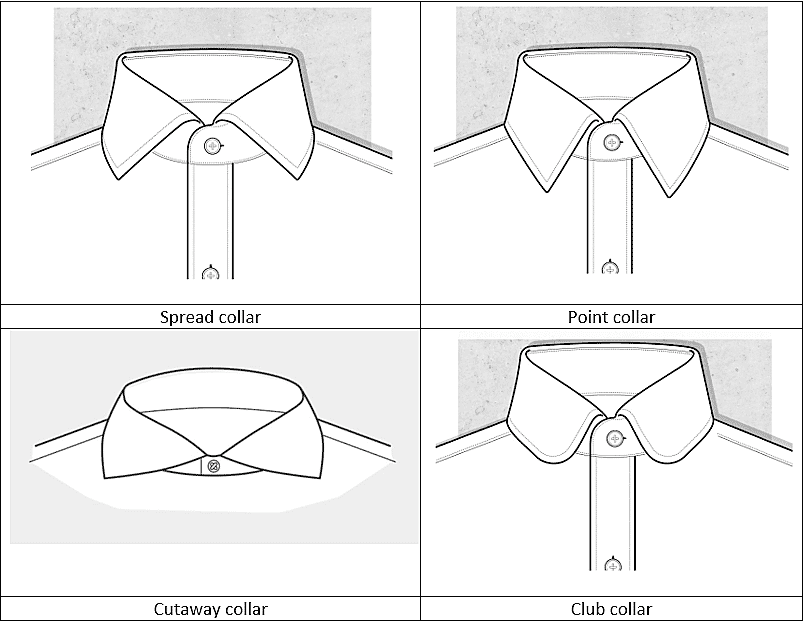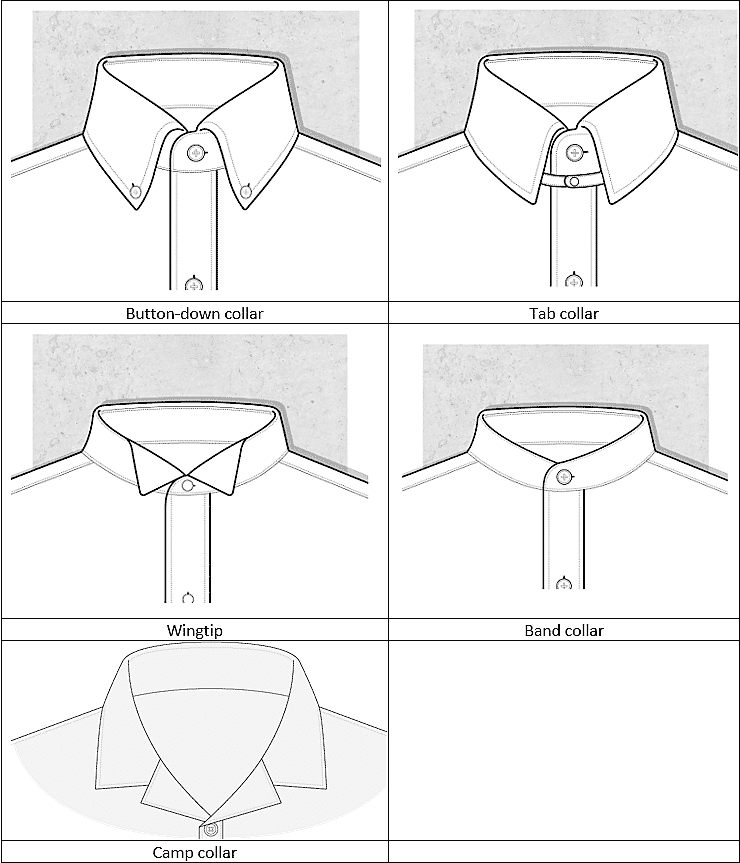Cookies
We use cookies on our website to give you the best service possible. Read more here.
Shirts are an important staple of a man’s wardrobe and collars are one of the most prominent aspects of shirts. Your tastes and the level of formality of the event you are attending should dictate the type of collar you wear.
In this guide, we will detail the main types of collar styles and explaining how to choose the right collar for you.
There are many types of collars to choose from. Each one has its own unique style. In this section, we will detail the unique aspect of each collar style and offer further fashion advice.
The spread collar is a very popular and considered one of the staples of British and European style. It was popularized in the 1920s by the Prince of Wales, an international trendsetter who did more than any other man to set the style for men’s dress in the 20th century and beyond.
The spread collar offers a wider collar to accommodate wider tie knots or ties made from thicker materials. The PoW’s famous “Windsor knots” were in fact regular four-in-hand knots, but made with a special interlining to produce the bulkier knots he favored.
There is a variation of the spread collar known as a semi-spread collar (or small-spread collar). This simply has a slightly smaller spread of 4” rather than 5”.
The point collar (also known as the forward-point collar or straight-point collar) is the most traditional of all collar-types. It has the narrowest distance between collar points (1.5” - 3.5”), to meet the lapels on both sides. It also means your tie will fit snugly without any gap either side.
As the name suggests, the point collar is defined by the point collar tips. The elongated and pointed tips create a thinning effect, chiselling away breadth and width in the face above. making it particularly suitable for those with wider faces and shorter necks.
Casual-point (also known as unlined) is a variation of the point collar. The difference being is that casual point has less interlining which makes it softer and gives it more movement. This gives the collar a less stiff, structural look. Casual-point shirts offer a more casual style than a standard point collar shirt.
The cutaway collar offers a bold, dramatic, and rather formal look.s. When worn open, without a tie, it tends to look unbalanced, falling/flying off the wearer’s shoulders rather than framing his face. It has one of the widest distances between collar points – 6" or more. This can create dramatic angles which cut away from the face. The extreme width leaves a part of the collar band visible on either side of the tie, which gives a somewhat old-fashioned, Edwardian effect. It is well suited for men who prefer to fill this space with a bulbous Windsor knot.
As legend has it, 19th century American clothier John Brooks observed how English polo players wore their collars buttoned down to prevent them flapping in their faces during matches. Upon returning home, he immediately introduced his version of what he called a “polo shirt.”
The Brooks Brothers button-down has gone on to become an icon of American style, embraced the world over for its soft, unlined comfort and casually distinctive “roll.” Sufficiently dressy with a tie, the button-down collar is most elegant when worn open, when its long points stand proud rather than collapsing under jacket lapels as many other collars do.
The button-down collar is increasingly seen worn open with the points unbuttoned, effectively making it an unlined point collar.
Another vestige from the era of detachable collars, band collared shirts are essentially shirts without collars at all. The “band” is in fact the collar stand, to which a detachable collar would once have been attached with brass studs. As these collars were generally stiffly starched and uncomfortable, workers and farmers went without them whenever they could, which gave this look a rustically relaxed and unpretentiously proletarian feel that persists today.
There are two types of band-collared shirt – The mandarin collar, which takes its name from its Chinese origins and the grandad collar when worn with an American rustic style.
Key features
This distinctively round-pointed collar derives its name from its original popularity among the privileged denizens of Victorian gentlemen’s clubs in London. Widely considered anachronistic and rarely seen today, the club collar mainly appeals to dressers who embrace its old-school manner – often wearing it with an equally fastidious collar pin -- but it can also be played against type in more modern, casual ensembles.
Another invention credited to the Prince of Wales back in the 1920s, the tab collar features small tabs on either side of the collar which fasten with a button or snap behind the tie knot. This arches the tie up and out from the collar, imparting a pleasing three-dimensionality to this cynosure of a classic male ensemble. It is essentially a sleeker and less fussy means of accomplishing the same effect as a pinned collar.
Because a tab collar only works with a tie, it isn’t very versatile, but they can be for just the thing for a man seeking a subtle touch of extra nattiness.
The wingtip collar (or just wing collar) is , worn today only with formal white-tie and semi-formal black tie events. It is interesting to note that while it is the most formal (and least comfortable) collar a man may ever wear these days, it was originally conceived as a concession to comfort, with its downturned corners (or “wings”) offering some relief to Victorian Adam’s apples rubbed raw by high “Imperial” collars which lacked them.
The camp collar (also known as the Cuban collar) is a throwback to a classic style from the 1950s. You will likely have seen glamorous film stars wear camp shirts during luxurious holiday sequences. The camp collar sits flat against your skin for a relaxed look. Hawaiian shirts and bowling shirts both use camp collars.
The camp shirt has buttons lower to the chest, giving the collar an even more relaxed look with an open-collar style.
Like most elements of men’s clothing, collars exist on a spectrum of most to least formal, and certain outfits or occasions will dictate which one you should wear. A buttondown would be inappropriate to wear with black tie, for example, just as an extreme cutaway would be incongruous with a tweed jacket. Softer, unlined collars are best suited to more casual ensembles, while stiffer, more structured collars confer crisp authority to dressier looks.
By far the two most versatile and common types of collar are spread collars and point collars (of which buttondowns are a popular variant). In determining which of these plays your best line, it’s important to understand a collar as a frame for your face. Just as the shape and the proportions of a picture frame should complement the artwork within it, so too should your shirt collars be chosen to balance your features.
In this section, you will information to help you choose the right collar for your look and occasion.
Collars can help balance out your face size and shape by drawing the eyes and complimenting certain features. Below you will find collar recommendations for the type of face size and shapes. These aren’t set rules and the effect can be subtle, so feel free to experiment.
If you have a wide and round face, a point collar will suit your face best. The point collar is a classic style of collar that has a slimming effect on the wearers face. The distance between the points of the collar is smaller and point more vertically which help draw the eye downwards. We recommend you choose a collar with a standard or narrow spread to help enhance the slimming effect.
Spread collars are the best for thin and long faces. Spread collars are a modern style of collar which have a long distance between the collar points like the name suggests. The spread creates a widening effect to help balance out thin faces. The distance between the collar points can vary from semi/medium spread to full spread collar. The greater the spread the wider the effect.
A shirt collar band (the part of the collar that goes around your neck) can come in different sizes, measured from the fold down to the point. Taller collars can promote a sense of formality and class, whilst shorter collars are modern and chic. You will need to consider your neck length when choosing your shirt collar size to ensure a stylish look.
If you have a taller stature or a longer neck, you may want to consider choosing a taller collar size. Your neck length will be able to support longer collar sizes without looking oversized. It may not always feel appropriate to choose taller collar sizes, but the choice is available.
If you have a short neck, you should stick to standard height collars. Taller collars will cover more of your neck and may look oversized. Try to stick to collar bands approximately 1” in height. You may also benefit from collars with shorter collar points to balance the length of your neck.
Certain types of collars suit certain types of occasions better than others. Depending on the type of event you are attending, you may wish to go bold or reserved.
If you are attending a formal event, it is best to play it safe. Choose collars of standard sizes and shapes. Point collars are also recommended as they are considered a more classic style than wider spreads.
You have much more flexibility in style at casual events. Try experimenting with larger collars and wider spreads. Button-down collars offer a relaxed look that is very low maintenance. The buttons hold down the collar points to ensure a casual yet smart look.
Remember that these are just guidelines. Don’t discount what you simply like, whether or not it’s supposedly flattering. There’s no rule that can’t be bent of broken by a savvy dresser who knows what he likes.

